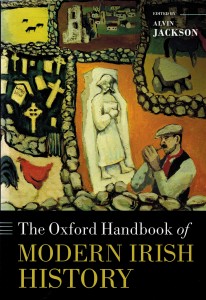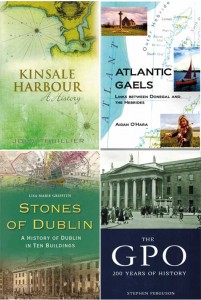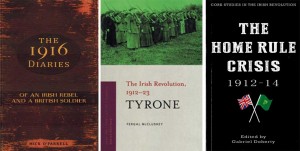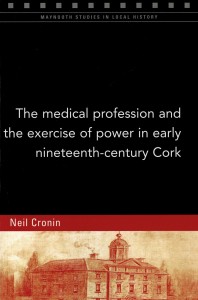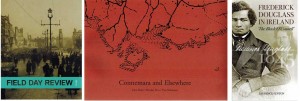Bookworm
Published in Issue 6 (November/December 2014), Reviews, Volume 22Alvin Jackson (ed.), The Oxford handbook of modern Irish history (Oxford University Press, £95 hb, 800pp, ISBN9780199549344)
Maynooth Studies in Local History (Four Courts Press, ?9.95 pb)
John R. Thullier, Kinsale Harbour: a history (Collins Press, ?19.99 hb, 280pp, ISBN 9781848892064)
Aidan O’Hara, Atlantic Gaels: links between Donegal and the Hebrides (The Islands Book Trust, £6 pb, 44pp, ISBN 9781907443497)
Lisa Marie Griffith, Stones of Dublin: a history of Dublin in ten buildings (Collins Press, ?17.99 pb, 304pp, ISBN 9781848892194)
Stephen Ferguson, The GPO: 200 years of history (Mercier Press, ?14.99 pb, 224pp, ISBN 9781781172773)
Mick O’Farrell, The 1916 diaries of an Irish rebel and a British soldier (Mercier Press, ?14.99 pb, 192pp, ISBN 9781781172445)
Fergal McCluskey, The Irish revolution, 1912–23: Tyrone (Four Courts Press, ?19.95 pb/?45 hb, 212pp, ISBN 9781846823008)
Gabriel Doherty (ed.), The Home Rule Crisis, 1912–14 (Mercier Press, ?19.99 pb, 448pp, ISBN 9781781172452)
Seamus Deane and Ciaran Deane (eds), Field Day Review 10 (Field Day Publications, ?25 pb, 224pp, ISBN 9780946755608)
Jane Conroy (ed.), Connemara and elsewhere (Royal Irish Academy, ?30 pb, 148pp, ISBN 9781908996374)
Laurence Fenton, Frederick Douglass in Ireland: the ‘Black O’Connell’ (Collins Press, ?12.99 pb, 240pp, ISBN 9781848891968)
This edition of Bookworm begins with a very big book indeed: The Oxford handbook of modern Irish history, edited by Alvin Jackson. This is truly a blockbuster: 37 chapters by leading scholars on a comprehensive range of topics, from thematic studies to more standard chronological accounts of Irish history since the later sixteenth century, cumulatively amounting to a panoramic prospectus of the current state of Irish historiography. There are some omissions: geography and class surely deserved chapters of their own. Equally, while most of the contributors are established scholars, justifiably included by dint of authority, a few more ‘young guns’ might have been worth including. But a book of this nature will always offer an eclectic mix of topics and contributors, and these minor gripes should not diminish the achievement: this will be immensely useful as a reference book for anyone interested in modern Irish history for years to come. It’s a pity about the stiff price, but hopefully a paperback will come out eventually.
From the large to the small: the latest batch of the invariably en-gaging Maynooth Studies in Local History are out and, as always, they range widely over time and space: Rory Masterson, Medieval Fore, County Westmeath; Marion Rogan, Charles Tisdall of County Meath, 1740–51; Neil Cronin, The medical profession and the exercise of power in early nineteenth-century Cork; Michael Kelly, Struggle and strife on a Mayo estate, 1833–1903: the Nolans of Logboy and their tenants; and Emmet O’Connor, Derry labour in the age of agitation, 1889–1923, 1: New unionism and old, 1889–1906. A larger and more wide-ranging local study is John R. Thullier’s Kinsale Harbour: a history. The fact that the title of this substantial account of the eponymous inlet does not reference the town of Kinsale indicates, rightly, that the author is more concerned with the maritime history and significance of what was, for much of its history, one of the most significant harbours in Ireland. And maritime history at the other end of the country is touched upon in Aidan O’Hara’s much briefer Atlantic Gaels: links between Donegal and the Hebrides.
Dublin has featured quite a bit in Bookworm lately and the trend continues here. Lisa Marie Griffith’s Stones of Dublin: a history of Dublin in ten buildings is a handsome and engaging account of the capital’s history, told through the varying careers of ten of its iconic buildings: Christ Church, Dublin Castle, Trinity College, the Bank of Ireland, City Hall, Croke Park, the Guinness Brewery, Kilmainham Gaol, the Abbey Theatre and the GPO. The latter building is likely to be an essential backdrop to the centenary of the Easter Rising in 2016 but has had a lengthy career on either side of 1916; after all, it was opened in 1818 and is still in business. The history of one of Dublin’s major public buildings is explored in Stephen Ferguson’s The GPO: 200 years of history, which casts light not only on the building but also on the institution that it housed and the society in which it operated. It is copiously illustrated with, amongst others, a vast range of images from the GPO’s Museum and Archive collection.
Speaking of 1916, the release of testimonies from the Bureau of Military History and Military Service Pension Collection in recent years has cast much light on the perspectives of participants in the Rising. But the British side remains relatively unexplored. Mick O’Farrell, The 1916 diaries of an Irish rebel and a British soldier, publishes two contrasting diaries from either side of the battle.
Four Courts Press have released the second in their new series of county histories of the revolution: Fergal McCluskey’s The Irish revolution, 1912–23: Tyrone. Mercier Press has also launched a new series, entitled ‘Cork Studies in the Irish Revolution’, the first of which is The Home Rule Crisis, 1912–14, edited by Gabriel Doherty. Based on an ongoing series of annual conferences being held in UCC, future volumes will deal with the 1913 Lockout, the First World War, the international dimension to the revolution, 1916 and much else besides. Of particular interest is the editor’s own contribution: an insightful survey of the various ways in which the centenary of the Home Rule crisis was commemorated (essential reading for various commentators!). It is to be hoped that similar surveys of commemoration will feature in the future volumes in the series.
History looms large in Field Day Review 10 (2014), edited by Seamus Deane and Ciaran Deane. The latest edition of this ever-lavish journal contains articles on the 1822 riots around the statue of William of Orange that stood on Dublin’s College Green from 1701 to 1928, the attitude of Roger Casement towards the outbreak of the First World War, and the question (explored by Brendan O’Leary) of why so many Irish historians are reluctant to think of Irish history in colonial terms. Of particular interest to readers of History Ireland will be Niall Meehan’s lengthy examination of the work of the late Peter Hart, which draws together a range of the author’s critiques into what is surely his last word on the matter. But the standout piece is by the eminent British social historian Patrick Joyce, the son of Irish emigrants, who mixes history and memoir to remarkable effect in his account of his childhood in London and its enduring connections with his father’s home in Connemara.
Tim Robinson is the great modern chronicler of Connemara; while not, strictly speaking, history, the past looms large in his work, a remarkable and handsome introduction to which is provided by Jane Conroy (ed.), Connemara and elsewhere, the core of which is a photographic essay that seeks to respond to Robinson’s excursions into the past and present of the eponymous western region. It also includes some unpublished essays by Robinson himself. Finally, readers who enjoyed Laurence Fenton’s article on Frederick Douglass’s journey to Ireland in 1845 in our last issue may be interested in his scholarly and very readable account of what Douglass actually did when he arrived here: Frederick Douglass in Ireland: the ‘Black O’Connell’.











